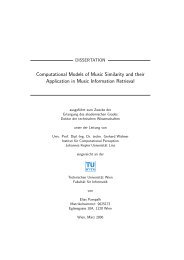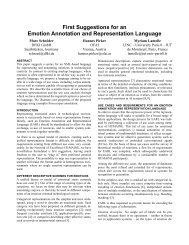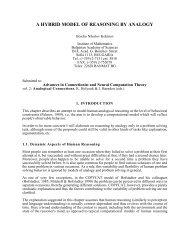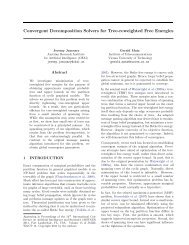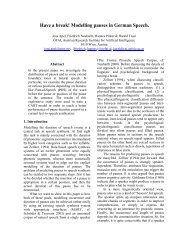Global Musical Tempo Transformations using Case Based ... - OFAI
Global Musical Tempo Transformations using Case Based ... - OFAI
Global Musical Tempo Transformations using Case Based ... - OFAI
Create successful ePaper yourself
Turn your PDF publications into a flip-book with our unique Google optimized e-Paper software.
Creek’s knowledge representation is implemented <strong>using</strong> an knowledge<br />
base. This object knowledge base is a structure of frames (a notion proposed<br />
by Minsky [83]) that contains domain concepts (e.g. ‘car’, ‘battery’,<br />
and ‘has-color’) as well as problem solving and learning task concepts (such as<br />
‘symptom’, ‘case-index’). In addition to the concept definitions, the knowledge<br />
base contains a set of solved cases, and additional domain knowledge<br />
in the form of heuristic rules. Furthermore there is a problem solving component.<br />
This component handles new problems by trying to find frames in<br />
the knowledge base that match features in the problem description. In this<br />
way, the system tries to ‘understand’ the problem, by integrating it into the<br />
knowledge base. If the features give a reminding of a solved case in the knowledge<br />
base, and this reminding has a strength above a certain threshold, then<br />
a CBR approach will be tried to solve the problem. If no case is retrieved, or<br />
the strength value is too low, then a RBR approach is taken. The strength<br />
threshold parameter should be dependent on the ratio of the performance of<br />
the RBR and CBR subsystems respectively (e.g. if the system has a wellperforming<br />
rule set at its disposal and a relatively small number of solved<br />
cases, the strength parameter is increased to favor RBR). If RBR fails as<br />
well, MBR could be tried as a resort.<br />
The reasoning phase is preceded by a spreading of activation through the<br />
frame network: The problem feature frames and the concepts representing<br />
the goal are given an initial activation, and this activation is spread out along<br />
related frames. The ‘paths’ of activated concepts that connect the problem<br />
and goal concepts, form the set of concepts that is used in either CBR or<br />
MBR (whichever approach is chosen).<br />
After a problem has successfully been solved, learning in Creek takes<br />
place by strengthening the remindings of the problem features to the case<br />
that was used to solve the problem. The newly solved problem is stored in<br />
the knowledge base by trying to generalize the case that was used for problem<br />
solving to subsume the new case. If the problem was solved <strong>using</strong> RBR or<br />
MBR, the problem and its solution are stored as a new case.<br />
3.4.1 NOOS: a Knowledge Representation Language<br />
Arcos and Plaza [9, 7] have designed NOOS a language to support the development<br />
of knowledge intensive problem solving systems. The language<br />
allows the user firstly to specify his problem by defining an ontology, containing<br />
all the types of objects that figure in the problem. Secondly, a domain<br />
model is constructed to capture the facts about the problem domain. In a<br />
system that should diagnose car defects, the domain model would for example<br />
contain facts like ‘’. Thirdly, the user provides problem solving methods,<br />
44




